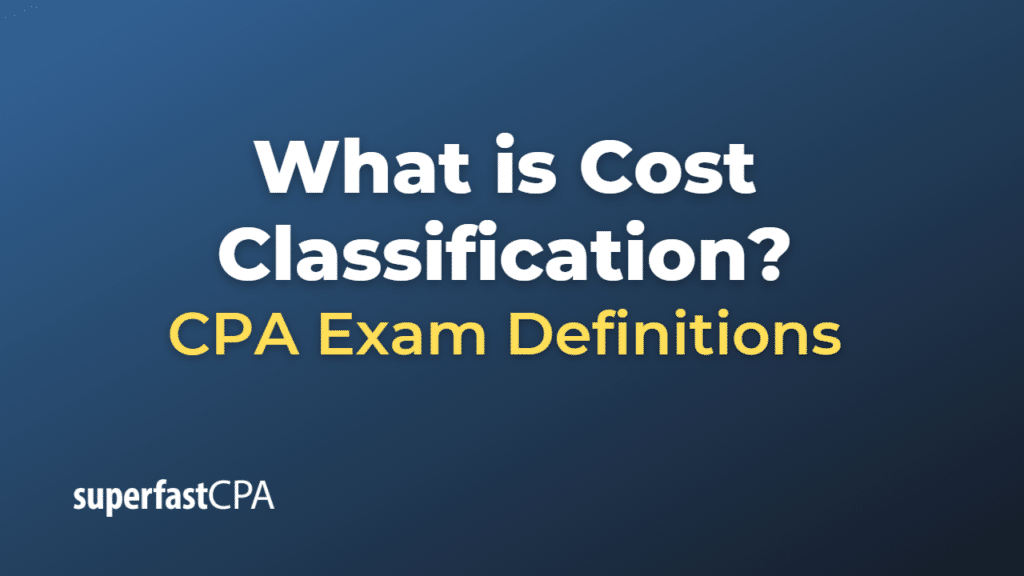Cost Classification
Cost classification refers to the process of categorizing costs based on their characteristics, nature, or behavior. This categorization helps organizations better understand and manage their costs, which can lead to more accurate budgeting, pricing, and decision-making. Cost classification is a fundamental aspect of cost accounting and management accounting.
There are several ways to classify costs, depending on the specific needs or objectives of an organization. Some common methods of cost classification include:
- Based on the function or purpose:
- Production costs: Costs incurred in manufacturing goods or providing services, such as direct materials, direct labor, and factory overhead.
- Selling costs: Costs related to the selling and distribution of products, such as advertising, sales commissions, and shipping expenses.
- Administrative costs: Costs related to the overall management and administration of the organization, such as salaries for management personnel, office rent, and office supplies.
- Based on the cost behavior:
- Fixed costs: Costs that remain constant within a specific range of activity or time, regardless of changes in production or sales volume. Examples include rent, insurance, and salaries for permanent staff.
- Variable costs: Costs that change in direct proportion to changes in production or sales volume. Examples include raw materials, direct labor, and shipping expenses.
- Mixed (semi-variable) costs: Costs that have both fixed and variable components, such as utility bills, which may include a fixed monthly service charge and a variable charge based on usage.
- Based on traceability to products or services:
- Direct costs: Costs that can be directly traced to a specific product or service, such as raw materials and direct labor.
- Indirect costs: Costs that cannot be directly traced to a specific product or service and are instead allocated across multiple products or services, such as factory overhead or administrative expenses.
- Based on the time horizon:
- Capital costs: Long-term costs related to the acquisition or improvement of fixed assets, such as buildings, equipment, or land.
- Operating (Revenue) costs: Short-term costs incurred during the ordinary course of business operations, such as wages, raw materials, and utility expenses.
These are just a few examples of how costs can be classified. The choice of cost classification method depends on the specific needs and objectives of the organization, as well as the type of information required for decision-making, budgeting, and performance evaluation.
Example of Cost Classification
Let’s consider a fictional company, “PaperCraft Inc.,” which produces and sells custom-designed stationery. PaperCraft Inc. wants to classify its costs to better understand and manage its expenses, improve decision-making, and enhance overall financial performance.
Here are some examples of cost classification for PaperCraft Inc.:
- Based on the function or purpose:
- Production costs: Costs of paper, ink, printing equipment maintenance, and labor for operating the printing machines.
- Selling costs: Advertising expenses, sales commissions for the sales team, and shipping costs for delivering the products to customers.
- Administrative costs: Salaries for management and office staff, rent for the company’s headquarters, and office supplies.
- Based on the cost behavior:
- Fixed costs: Rent for the production facility, salaries for permanent staff, and insurance premiums.
- Variable costs: Costs of paper and ink (which vary depending on the number of stationery items produced), and sales commissions (which vary depending on sales volume).
- Mixed costs: Electricity bills for the production facility and headquarters, which include a fixed monthly service charge and a variable charge based on usage.
- Based on traceability to products or services:
- Direct costs: Paper and ink used for each stationery item, and direct labor costs for operating the printing machines.
- Indirect costs: Depreciation of printing equipment, salaries for management and office staff, and rent for the company’s headquarters.
- Based on the time horizon:
- Capital costs: Purchase of new printing equipment, acquisition of a new production facility, or investments in software for designing stationery.
- Operating costs: Wages for production staff, costs of paper and ink, and advertising expenses.
By classifying its costs using these methods, PaperCraft Inc. can gain a better understanding of its cost structure, identify inefficiencies, and make more informed decisions regarding pricing, resource allocation, and cost control measures. This will ultimately contribute to the company’s overall financial performance and long-term success.













